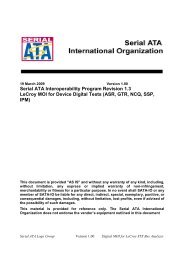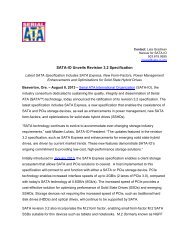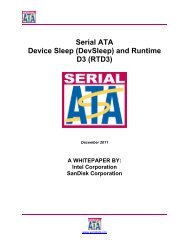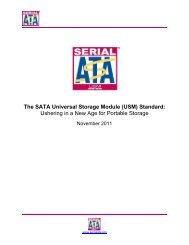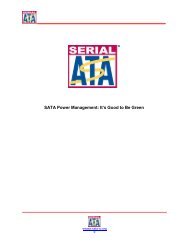1.0 - SATA-IO
1.0 - SATA-IO
1.0 - SATA-IO
- No tags were found...
You also want an ePaper? Increase the reach of your titles
YUMPU automatically turns print PDFs into web optimized ePapers that Google loves.
Tektronix, Inc.Test RX-05 – Impedance BalancePurpose: To verify that the Impedance Balance of the PUT’s receiver is within the conformance limits.References:[1] <strong>SATA</strong> Standard, 7.2.1, Table 23 – Receiver Specifications[2] Ibid, 7.2.2.4.5[3] Ibid, 7.4.10[4] <strong>SATA</strong> unified test document, 2.13.5Resource Requirements:See Appendix A.Last Template Modification: April 10, 2006 (Version <strong>1.0</strong>)Discussion:Reference [1] specifies the Transmitted Signal conformance limits for <strong>SATA</strong> devices. This specificationincludes conformance limits for the RX Impedance Balance. Reference [2] provides the definition of this term forthe purposes of <strong>SATA</strong> testing. Reference [3] defines the measurement requirements for this test.Test Setup:1. Matched length SMA cables have to be connected to the TDS/CSA8200 sampling oscilloscope; eachpair of the transmitter and receiver is connected to one sampling module.2. The TDR signal amplitude should be less than 300mV peak-to-peak. This can be achieved byintroducing 6dB attenuators in the measurement path, this will provide approximately 125mV peak-topeak(single ended) TDR signal amplitude3. Each sampling module of the oscilloscope needs to be deskewed for acquisition external signal sourcebefore connecting the fixtures. There is no need to deskew between the modules since themeasurements are done for the pairs within the modules. The deskew is to be performed in even mode:both sources are positive, and the step signals should arrive at the PUT and the same time. Theinstrument’s setup needs to be saved to a file.4. Set 4000 acquisition points and 1ns/div in “Horizontal” menu and 300 averages in the “Acquisition”menu of TDS8200. Set math 1 function to the sum of the acquired TDR channels, and acquire openreference waveform at the SMA interface. Set math 2 function the difference of the acquired TDRchannels and filter the response to 40ps (10-90%) rise time.5. Power up the product under test (PUT) and complete a full OOB sequence..Test Procedure:1. This procedure should be applied to the worst case port (in a multi-port system/host) as determinedthrough the worst case port identification MOI.2. Load the open reference for even mode (math 1 function) using IConnect “Acquisition” tool.3. Connect the fixtures and the PUT then acquire math 2 waveform (difference of the acquired TDRsignals) using IConnect “Acquisition” tool.4. Use S-parameter tool of IConnect to compute differential-to-common conversion (Sdc11) of the PUT.The resulting waveform will be displayed in the frequency domain viewer.5. Using cursors measure the maximum values for each frequency range given in reference [1].Impedance balance measurements are shown in Figure 4.5.6. Record the results.<strong>SATA</strong> Rx/Tx MOI Revision 1.1 ver <strong>1.0</strong>37




